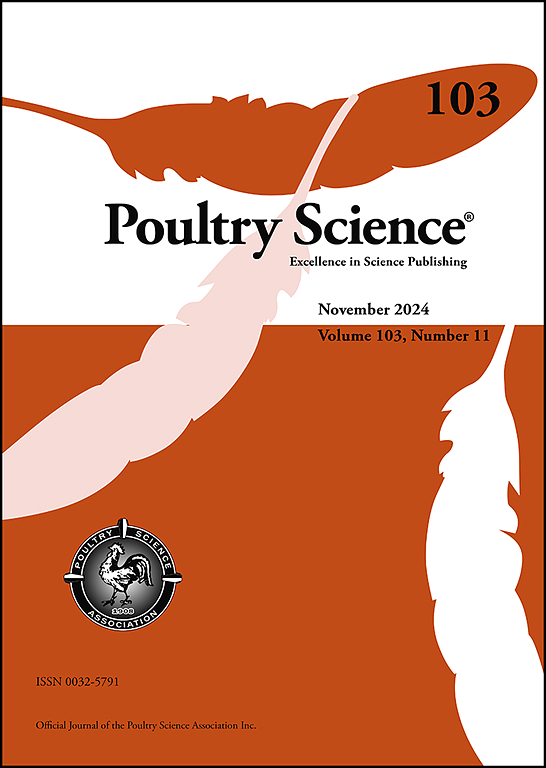The influence of genetic strain on production and egg quality amongst four strains of laying hens housed in a cage-free environment
IF 3.8
1区 农林科学
Q1 AGRICULTURE, DAIRY & ANIMAL SCIENCE
引用次数: 0
Abstract
As the United States egg industry transitions towards cage-free production, genetic strains must be evaluated in their performance in these alternative environments. Transitioning strains that were selected for caged production may elicit challenges in their adaptation to alternative systems, so it cannot be assumed that egg production and quality parameters are comparable in various environments. White strains are historically associated with caged production while brown strains typically occupy cage-free systems. Therefore, the aim of this study was to evaluate the influence of genetic strain on egg production and quality in a cage-free environment. Hy-Line W-36 White, H&N White, Hy-Line Brown, and Bovan Brown laying hen strains were evaluated through numerous egg production and quality parameters throughout the entirety of a lay cycle. H&N White hens in this study were the lowest producing strain demonstrated by producing the least amount of eggs per hen, having the lowest hen-day egg production (p < 0.0001), producing the fewest USDA grade A eggs (p = 0.0023), and the most check eggs (p = 0.0006). However, the Bovan Browns were the least efficient strain as this strain consumed the most feed and had the lowest feed conversion ratio (p < 0.0001). Overall, both white strains demonstrated poorer egg quality compared to brown strains. Hy-Line W-36 White hens had the lowest albumen height, Haugh unit score, yolk color, and yolk weight (p < 0.0001). H&N Whites had the lowest vitelline membrane strength, shell weight, and shell thickness (p < 0.0001). In conclusion, the Hy-Line Brown hens may be better suited for cage-free production based on overall greater egg production and quality metrics compared to the three other strains used in this study. Therefore, this research demonstrates that genetic strain did influence cage-free laying hen performance.
求助全文
约1分钟内获得全文
求助全文
来源期刊

Poultry Science
农林科学-奶制品与动物科学
CiteScore
7.60
自引率
15.90%
发文量
0
审稿时长
94 days
期刊介绍:
First self-published in 1921, Poultry Science is an internationally renowned monthly journal, known as the authoritative source for a broad range of poultry information and high-caliber research. The journal plays a pivotal role in the dissemination of preeminent poultry-related knowledge across all disciplines. As of January 2020, Poultry Science will become an Open Access journal with no subscription charges, meaning authors who publish here can make their research immediately, permanently, and freely accessible worldwide while retaining copyright to their work. Papers submitted for publication after October 1, 2019 will be published as Open Access papers.
An international journal, Poultry Science publishes original papers, research notes, symposium papers, and reviews of basic science as applied to poultry. This authoritative source of poultry information is consistently ranked by ISI Impact Factor as one of the top 10 agriculture, dairy and animal science journals to deliver high-caliber research. Currently it is the highest-ranked (by Impact Factor and Eigenfactor) journal dedicated to publishing poultry research. Subject areas include breeding, genetics, education, production, management, environment, health, behavior, welfare, immunology, molecular biology, metabolism, nutrition, physiology, reproduction, processing, and products.
 求助内容:
求助内容: 应助结果提醒方式:
应助结果提醒方式:


